
Fuel cell vs battery electric vehicles – a comparison of alternative fuels
It’s well documented by now that fossil fuel vehicles are a significant contributor to carbon emissions – one passenger vehicle emits about 4.6 metric tons of carbon dioxide per year. To save our planet, we have to explore alternatives, and make these alternatives the mainstream on roads in the next 20-30 years. This is why it becomes increasingly important to explore fuel cell vs battery electric vehicles.
The main contenders as it stands are fuel cell vehicles and battery-operated electric vehicles – but how do they compare?
Fuel cells and batteries – what’s the difference?
At a fundamental level – it’s about how energy is accessed or stored that mainly differentiates fuel cell and battery-operated electric vehicles.
Batteries store electrical energy that you get from a charging point. Fuel cells, on the other hand, generate energy by converting the available fuel on-board (such as hydrogen) via a chemical reaction. Fuel cell electric vehicles (FCEVs) usually have a battery as part of their system to store the electricity generated by the fuel cell.
Now that we’ve outlined the difference between the two types of vehicles – how do they compare in terms of their efficiency and impact on the environment?
Emissions
It’s a hot topic in the field of alternative fuel vehicles – just how environmentally friendly are they? After all, although EVs and FCEVs have zero tailpipe emissions, the process of energy production on both sides is not emission-free.
Electricity
The environmental benefits of EVs largely come down to lifetime emissions. A study by the MIT Energy Initiative found that overall, battery and fuel production for an EV generates higher emissions than the manufacturing of an ICE vehicle, however, this is offset by their energy efficiency over time and zero tailpipe emissions. Research also suggests that the average lifetime emissions of electric cars are up to 70% lower in places like Sweden and France, where most electricity comes from renewables and nuclear, and around 30% lower in the UK. Reducing the overall impact of the production of energy for BEVs on emissions depends on transforming the grid and moving away from producing electricity with fossil fuels. The process of making the high-energy density batteries that power these vehicles (most commonly lithium-ion) is energy-intensive and can contribute 30-40% extra in production emissions, depending on the country of production.
Grey, blue and green hydrogen
Just as there is with electricity, there are different ways of producing hydrogen that have different levels of emissions and thus impact on the environment. Grey hydrogen is extracted from fossil gas, releasing CO2 into the air. Blue hydrogen attempts to offset this by trapping the CO2 emissions and storing them permanently underground. Green hydrogen is extracted from water using renewable electricity, emitting only oxygen into the air. Ostensibly, green hydrogen is the most preferable in terms of cutting emissions – but producing green hydrogen is currently expensive to produce (although it’s predicted that it will be cost-competitive by 2030). For that reason, blue hydrogen is commonly the avenue explored by governments as the most viable option. However, the method for producing blue hydrogen and storing the CO2 emissions still fails to capture up to 15% of the CO2 – meaning that blue hydrogen could create the same carbon emissions that more than a million petrol cars.
Efficiency
A significant drawback of hydrogen fuel cells in vehicles is energy efficiency. The overall energy efficiency of a battery-operated vehicle is around 70-80%, whereas the efficiency of a hydrogen fuel cell plummets to around 30-40%, due to the complex process that the hydrogens goes through (both before and after it gets to a vehicle) in order to generate energy. From the point at which the energy is generated, hydrogen goes through 5 processes before it powers a vehicle, losing on average 14% of efficiency at each stage. In comparison, electricity simply needs to be transported and stored.
There’s still work and innovation to be done in both fuel cell and battery-operated vehicles in order to make them as efficient and viable for mass markets as possible. When discussing ‘fuel cell vs battery electric’, the most important aspect to recognise for both is that it’s clear that over their lifetime, they represent a significant reduction in emissions compared to ICE vehicles.
Elmelin work closely with manufacturers in low-carbon vehicle technology to help improve the safety and efficiency of vehicles through innovative mica-based insulation solutions. If you’d like to find out more, get in touch.
